The GeForce GTX 660 Ti Review, Feat. EVGA, Zotac, and Gigabyte
by Ryan Smith on August 16, 2012 9:00 AM ESTOC: Power, Temperature, & Noise
Our final task is our look at the overclocking capabilities of our GTX 660 Ti cards. Based on what we’ve seen thus far with GTX 660 Ti, these factory overclocked parts are undoubtedly eating into overclocking headroom, so we’ll have to see just what we can get out of them. The very similar GTX 670 topped out at around 1260MHz for the max boost clock, and between 6.6GHz and 6.9GHz for the memory clock.
| GeForce 660 Ti Overclocking | |||||
| EVGA GTX 660 Ti SC | Zotac GTX 660 Ti AMP | Gigabyte GTX 660 Ti OC | |||
| Shipping Core Clock | 980MHz | 1033MHz | 1033MHz | ||
| Shipping Max Boost Clock | 1150MHz | 1175MHz | 1228MHz | ||
| Shipping Memory Clock | 6GHz | 6.6GHz | 6GHz | ||
| Shipping Max Boost Voltage | 1.175v | 1.175v | 1.175v | ||
| Overclock Core Clock | 1030MHz | 1033MHz | 1083MHz | ||
| Overclock Max Boost Clock | 1200MHz | 1175MHz | 1278MHz | ||
| Overclock Memory Clock | 6.5GHz | 6.8GHz | 6.6GHz | ||
| Overclock Max Boost Voltage | 1.175v | 1.175v | 1.175v | ||
As we suspected, starting with factory overclocked cards isn’t helping here. Our Zotac card wouldn’t accept any kind of meaningful GPU core overclock, so it shipped practically as fast as it could go. We were able to squeeze out another 200MHz on the memory clock though.
Meanwhile our EVGA and Gigabyte cards fared slightly better. We could push another 50MHz out of their GPU clocks, bringing us to a max boost clock of 1200MHz on the EVGA card and 1278MHz on the Gigabyte card. Memory overclocking was similarly consistent; we were able to hit 6.5GHz on the EVGA card and 6.6GHz on the Gigabyte card.
Altogether these are sub-5% GPU overclocks, and at best 10% memory overclocks, which all things considered are fairly low overclocks. The good news is that reference-clocked cards should fare better since their headroom has not already been consumed by factory overclocking, but binning also means the best cards are going to be going out as factory overclocked models.
Moving on to our performance charts, we’re going to once again start with power, temperature, and noise, before moving on to gaming performance.

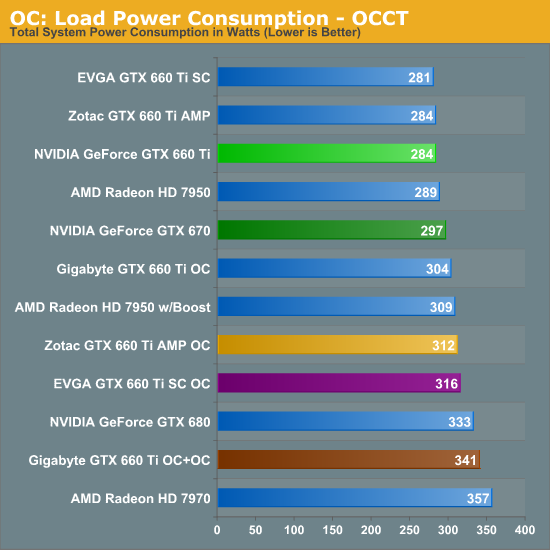
Unsurprisingly, given the small power target difference between the GTX 670 and the GTX 660 Ti, any kind of overclocking that involves raising the power target quickly pushes power consumption past the GTX 670’s power consumption. How much depends on the test and the card, with the higher power target Gigabyte card starting with a particular disadvantage here as its power consumption ends up rivaling that of the GTX 680.
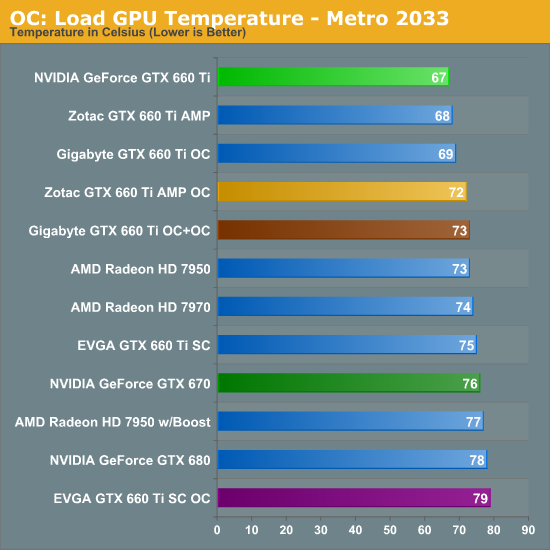
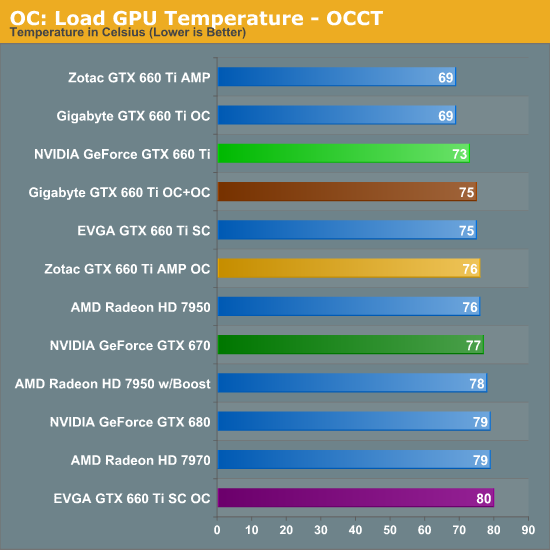
We also see the usual increase in load temperatures due to the increased power consumption. The Zotac and Gigabyte cards fare well enough due to their open air coolers, but the blower-type EVGA card is about as high as we want to go at 80C under OCCT.
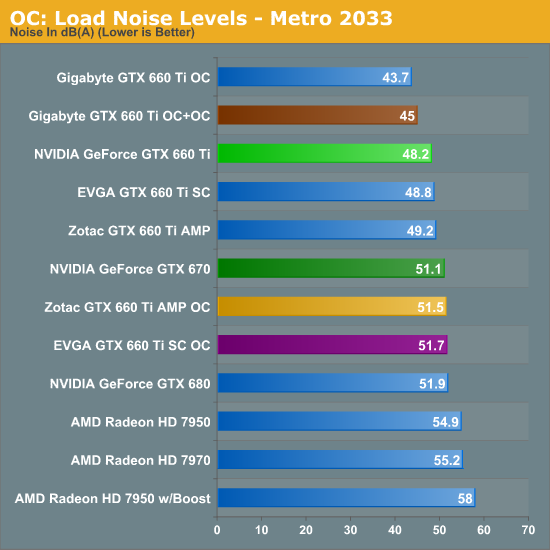
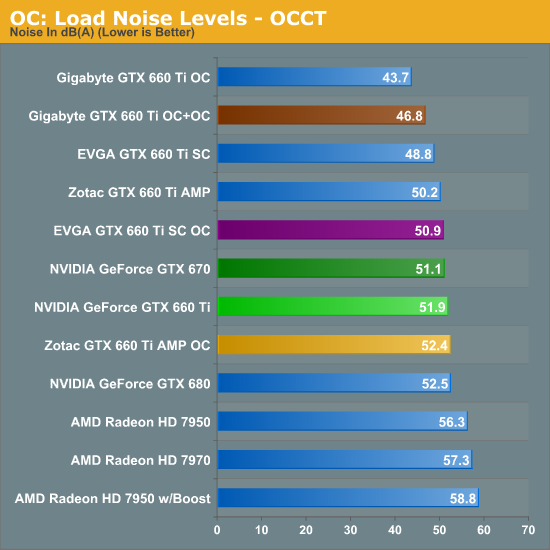
Last but not least, looking at noise levels we can see an increase similar to the temperature increases we just saw. For the Zotac and EVGA cards noise levels are roughly equal with the reference GTX 680, which will be important to remember for when we’re looking at performance. Meanwhile the Gigabyte card continues to shine in these tests thanks to its oversized cooler; even OCCT can only push it to 46.8dB.










313 Comments
View All Comments
RussianSensation - Thursday, August 16, 2012 - link
Oops forgot to link it:$317 HD7950 MSI TF3 -- perfect for skyrim with mods:
http://forums.anandtech.com/showthread.php?t=22616...
CeriseCogburn - Thursday, August 23, 2012 - link
BUT IT LOST to the 660Ti, and the 660Ti even beats the 7970 LOLhttp://www.bit-tech.net/hardware/2012/08/16/nvidia...
Oh well, time for a new game plan...
1300+ on 660Ti cores, exceeding 7950's and 7950's - R O F L goodbye amd
Ryan Smith - Saturday, August 18, 2012 - link
If you're going to be playing with memory-intensive mods then our Skyrim results at 2560 are going to be the most relevant. The 7870 would be appreciably faster here, but note that this is basically the only case in our entire benchmark suite where that happens (even Crysis has the two virtually tied). I suspect you'd be happy with either card, but if you intend to keep the card for a while and to play games other than Skyrim, I'd be hesitant to recommend the 7870.TheJian - Monday, August 20, 2012 - link
Not quite sure I understand...660TI is dominant in 1920x1200 in skyrim. I already showed from the hardware survey at steampowered.com <2% use your resolution of 2560x1600. I already pointed out 68 24in monitors at newegg (that's all of them by the way) don't recommend above 1920x1200/1080 for recommended res (native), 41 of the 27in monitors run the same, only 11 27in monitors on newegg recommend a resolution even near your 2560x1600 (it's 1440 on those 11), the rest of the other 41 27in models are also 1920x1080...Who do you think runs at this 2650x1600 res? It's a res used by a small % of the 2% I've just mentioned. You have to buy a 30in before this is useful info. Is this guy running a 30in? Crysis, tied? You talking warhead from an old engine from 2008 or what? See my other posts, you need to rewrite your conclusion and stop acting like there are more than 2% in the world using 2560x1600. I already proved this wrong many times in here in the comments on this article! Got any evidence skyrim is better for this guy? His link where nothing is explained? I believe he's testing at REF speeds for the 660TI since nothing is mentioned about what he runs the tests at (after translating the whole thing through google) . He has multiple cards but only 1 660TI in the test once he gets to the alan wake page and gaming tests. Again though, 1920x1080 the card is great. But still I have no idea of the clockspeed of the ONE card in the 3 card charts. Only ArmA2,Metro2033 seems to be a victory for 7950 (again at what speed?). I can't find evidence it's not all based on reference. But if you go by your benchmarks, hardocp, guru3d etc...It's clear who wins at the res 98% of us use. Our can you point me to 2560x1600 data showing otherwise? 2560x1600 isn't used. I pointed out all the monitors at newegg...Steampowered survey...Where is evidence it's used?
Burticus - Thursday, August 16, 2012 - link
The 570 is included in the benchmarks which the 660TI just slaps down. Why no 580?I can pick up a used EVGA 580 for $250, so I am curious. I like the sound of the Gigabyte 660TI but it's $319... is it worth $70 more than a 580? Yes I know power consumption will be lower and it will be less noisy.
Roland00Address - Thursday, August 16, 2012 - link
Here are the resultshttp://www.anandtech.com/bench/Product/647?vs=517
rarson - Friday, August 17, 2012 - link
Yeah, bench is sometimes even more useful than the benchmark charts in product reviews (especially when the review was written by Jarred).Galidou - Sunday, August 19, 2012 - link
When you look at power and temperature bars at the bottom, it's plain amazing! They surely got the sweet spot this time. Thinking the 660 ti performs a little better but such a difference in power usage, there's not much to say about it except it's plain extraordinary.Ryan Smith - Saturday, August 18, 2012 - link
The GTX 570 was included since at current prices the GTX 660 Ti is more or less replacing that card. I do not know of many people who would be considering a GTX 660 Ti as a GTX 580 replacement.beastyben1 - Thursday, August 16, 2012 - link
I see 11 different models that just became available - not a soft launch.The Galaxy's cooler looks quite interesting and has a pretty beefy heatsink.